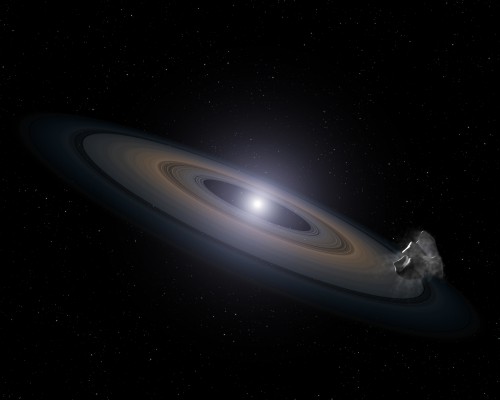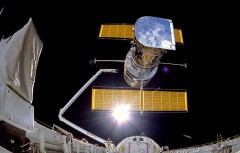
Almost a quarter of a century since its launch—and four years since last touched by the hands of humans—NASA’s Hubble Space Telescope continues to amaze, by finding the building blocks for Earth-sized planets in the atmospheres of a pair of distant white dwarfs. The dead stars are located about 150 light-years from us, deep within a relatively young 625-million-year-old star cluster, Hyades, in the constellation of Taurus. According to the new Hubble results, the white dwarfs are in the process of being polluted by asteroid-like debris falling onto them.
Hubble’s Cosmic Origins Spectrograph (COS) observed traces of silicon and low levels of carbon in their atmospheres, both of which are important ingredients in planetary composition. Silicon is a major constituent of the rocky material in our Solar System’s “solid” planets, whilst carbon is generally depleted or absent in rocky, Earth-like material. “We have identified chemical evidence for the building blocks of rocky planets,” explained Jay Farihi of the University of Cambridge in England. He is the lead author of a new study, to appear in the Monthly Notices of the Royal Astronomical Society. “When these stars were born, they built planets, and there’s a good chance they currently retain some of them. The material we are seeing is evidence of this. The debris is at least as rocky as the most primitive terrestrial bodies in our Solar System.”

As well as suggesting that rocky-planet assembly is common around distant stars, Hubble’s data offers insights into what will happen to our own Sun and its attendants at the end of its life, 5 billion years into the future. According to Farihi, silicon-rich asteroids less than 100 miles in diameter were probably torn apart by the white dwarfs’ strong gravitational forces and were then possibly pulled into a “ring” of debris and eventually funneled onto their surfaces. “It is difficult to imagine another mechanism than gravity that causes material to get close enough to rain down onto the star,” Farihi said.
By the same token, when our Sun nears the end of its life and burns out, the balance of gravitational forces between it and the largest planet in the Solar System, Jupiter, will change, disrupting the main asteroid belt. Rocky objects which veer too close to the Sun will be torn apart and their debris might be pulled into a ring around our dead parent star. Farihi explained that using Hubble to analyse white dwarf atmospheres is a powerful tool for finding the “signatures” of solid-planet chemistry and composition.
“Normally, white dwarfs are like blank pieces of paper, containing only the light elements, hydrogen and helium,” he explained. “Heavy elements like silicon and carbon sink to the core. The one thing the white dwarf pollution technique gives us that we just won’t get with any other planet-detection technique is the chemistry of solid planets.” More than 100 white dwarfs, including the “polluted” Hyades pair, are presently under investigation, as part of a search led by Boris Gansicke of the University of Warwick in England.
Want to keep up-to-date with all things space? Be sure to “Like” AmericaSpace on Facebook and follow us on Twitter:@AmericaSpace



